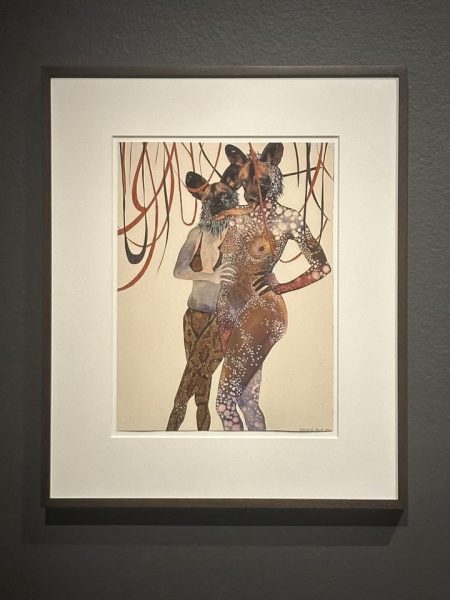
Since the New Orleans Museum of Art’s opening in 1911, it has been committed to celebrating a diversity of thought and identities. NOMA’s newest exhibit highlighting a Kenyan-American artist, “Wangechi Mutu: Intertwined,” is a nuanced look into the importance of artistic diversity, exploring what it means for art to become “intertwined.”
Born in 1972 in Nairobi, Wangechi Mutu is a Kenyan multimedia artist known for her Afrofuturistic and surrealist style, focusing on themes of colonialism, womanhood and the African Diaspora. As a child, Mutu was exposed to both creative and intellectual fields through her father, a political scientist and paper importer, showing her at an early age the connection between the study of culture and art.
In the late 1990s, Mutu moved to New York City to pursue fine arts and has split her time between the United States and Kenya ever since. The time Mutu has spent in both America and Kenya informs her work, and Mutu uses her art as a bridge between these two places, symbolizing the historical and social African diaspora through her move to America and commentary on Western culture. Mutu’s emphasis on duality is evident throughout her body of work and is made captivatingly clear in NOMA’s curation.
Last week, I met with NOMA’s head of marketing and communications, Charlie Tatum, who gave me a walkthrough of the Wangechi Mutu’s Intertwined exhibit. At the start of the tour, Tatum made note of the first piece in the collection, the collage for which the exhibit is named, entitled “Intertwined.”
Part of Mutu’s early 2000s mixed media series, the collage depicts two human female figures with the heads of African dogs, adorned with an intricate pattern of strings above their heads. On the women’s legs, Mutu uses watercolors and spray paint to create the illusion of animal skins and intentionally leaves one of the women’s breasts bare.
Mutu’s surrealist depiction of a human-animal hybrid in “Intertwined” enhances her focus on the representations of womanhood and African identities in popular culture. The nude women represent derogatory ways in which the media portrays women, but the addition of African dog heads comments on the harmful stereotypes in which Black women are portrayed. Tatum stated that “Intertwined” is not only important due to its profound social commentary, but also because the exhibit as a whole “speaks to the interconnectedness of people, places, cultures and ideas around the world” and is seen in this collage’s “figures with hybrid human and animal features.” By starting with this piece, NOMA’s curators captured the essence of Mutu’s work from the very beginning of the exhibit, and their careful attention was evident throughout my tour.
One of this exhibit’s most interesting choices was NOMA’s decision to display pieces from its historical African art collection alongside Mutu’s contemporary work. For something like Mutu’s work, I found that this choice made all the difference in emphasizing the African Diaspora alongside the concept of “Intertwined.” For instance, one room displayed Mutu’s 2017 representation of an African water deity entitled “Water Woman.” Directly opposite Mutu’s contemporary version was an early 20th century depiction of the same deity by an Ewe artist called “Mami Wata.”
The exhibit’s contrast between historical and contemporary African art captured the nature of “Intertwined,” illustrating Mutu’s connection with the African Diaspora along with historical implications, depicting the deep connections between the past and present. As we walked through the exhibit, Tatum made specific note of an installation’s importance on the exhibit, saying that elements like the historic African art, as well as smaller details like wall placement, “help visitors feel completely immersed in Mutu’s work as if they are in their own world.” I certainly felt this way as I discovered Mutu’s work for myself.
Open six days a week from now through July 14, “Wangechi Mutu: Intertwined” at the New Orleans Museum of Art is a must-visit for anyone interested in the arts, African culture or who simply wants to find a new experience in the city. While beautifully showcasing Mutu’s body of work, NOMA goes above and beyond to illustrate the importance of diversity and engage spectators, creating a truly “intertwined” experience that promises to pull you in.


